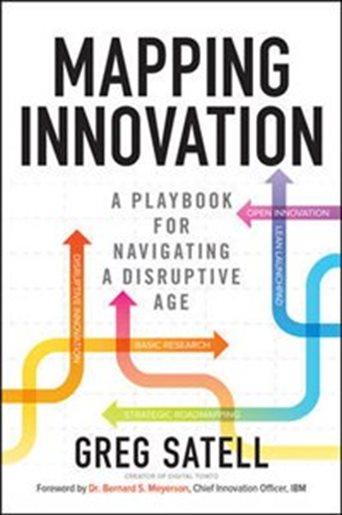Mapping Innovation Summary – Greg Sattel

6 min read ⌚
 A Playbook for Navigating a Disruptive Age
A Playbook for Navigating a Disruptive Age
With the digital revolution, a new era of innovation begun, brutally and succinctly summed up in the dictum “innovate or die.”
In “Mapping Innovation,” Greg Satell provides a lifeline for the companies on their deathbeds or in the maternity ward, by systematizing “the strategies of the world’s most inventive startups, corporations, and scientific institutions.”
Your only job: to apply them.
Who Should Read “Mapping Innovation”? And Why?
“Mapping Innovation” is not especially innovative in its first part – where it counters innovation “Eureka” fairytales with stories of collaboration and combination – but it is satisfactorily novel in Parts 2 and 3, where it offers a powerful framework for mapping innovation space and introduces you to the challenges of innovating in the digital age.
Read the first part if you are interested in the history of innovation and memorable anecdotes; read the latter two for their applicability and practical value.
 About Greg Satell
About Greg Satell
Greg Satell is a bestselling author and innovation advisor.
After spending a decade and a half building and managing business in Eastern Europe (Poland, Ukraine, Russia, and Turkey), he got a job as SVP at Moxie Interactive, a division of Publicis Groupe.
He is currently a regular contributor to “Inc” and “Harvard Business Review.”
“Mapping Innovation” is his first and, so far, only book.
“Mapping Innovation PDF Summary”
On December 9, 1968, something miraculous happened at the Association for Computing Machinery / Institute of Electrical and Electronics Engineers (ACM/IEEE) in San Francisco.
About thirty years later – when, retroactively, many could see the revolutionary significance of the event – Steven Levy (in his book about the life and times of the Macintosh, “Insanely Great”) would dub the happening “the mother of all demos.”
So, what was it?
Some Dr. Strangelove-inspired Doomsday weapon capable of trouncing the Soviets in a second? A Vietnam-related report which resulted in the Vietnamization program? The key insight which helped NASA go from Apollo 8 (about to be launched) to Apollo 11 in half a year?
No, of course not – you would know if it was one of those!
And, believe it or not, “the mother of all demos” was something even more notable.
Namely, a demonstration of “augmented human intellect” by “a mild-mannered engineer” named Douglas Engelbart.
To understand the context, just don’t forget that it is 1968 and that, in those days, very few people had ever seen a computer, let alone used one. To almost everybody on the planet, computers were about as mysterious then as, say, quantum physics is today.
But here was Engelbart, dressed in a short-sleeved white shirt and a thin black tie, standing in front of a 20-foot-high screen and explaining in his low-key voice how ‘intellectual workers’ could actually interact with computers. What’s more, he began to show them. As he began to type a document on a simple keyboard, words started to appear, which he could then edit, rearrange, and add graphics and sound to, while all the time navigating around the screen with a small device he called a mouse. Nobody had seen anything remotely like it before.
Unsurprisingly, the people present in the audience were fascinated.
Two of them – Bob Taylor and Allan Kay – would use Engelbart’s ideas to develop the Xerox Alto, which, when introduced on March 1, 1973, became the first computer capable of supporting an operating system based on GUI, aka, the first truly personal computer.
Six years later, in exchange for Apple stocks, Steve Jobs would receive a demonstration of the technology behind the Xerox Alto, and, with great fanfare, the Macintosh was launched in 1984, 16 years after the mother of all demos!
Add to all of this the fact that Engelbart himself was inspired by Vannevar Bush’s 1945 essay “As We May Think” which, in turn, could have only been written at the time John von Neumann was working the Von Neumann architecture model and only after Alan Turing devised the concept of the “universal computer.”
We could go on, but the point should be already blatantly obvious by now:
Innovation is never a single event, and… rather than following a linear path, effective innovators combine the wisdom of diverse fields to synthesize information across domains. If a problem is difficult enough, it needs to borrow from multiple fields of expertise. Innovation, more than anything else, is combination.
As Walter Isaacson has beautifully shown, rather than a recent radical event in the mind of a single intellect, the digital revolution was actually a process lasting for more than two centuries and needing the brilliance of “a group of hackers, geniuses, and geeks.”
Ironically, owing to the success of this very same revolution, now you and your company don’t really have the luxury of innovating (or recognizing innovation) with such a slow pace anymore.
On the contrary, you have to act as fast as possible.
And “Mapping Innovation” offers a few valuable tools which can help you do that.
We look over them in our “Key Lessons” section.
Key Lessons from “Mapping Innovation”
1. Innovation Is All About Defining the Problem
2. The Four Innovation Domains
3. The Innovation Playbook
Innovation Is All About Defining the Problem
As Greg Satell notes, “it is only by framing problems effectively that you can find the approach most likely to solve them.”
Consequently, all innovation starts with you defining the “innovation space” particular to your needs and expertise, by giving an answer to the question: “How well is the problem defined?” Only then you can answer the second question of crucial importance: “Who is best placed to solve it?”
For example, the iPod was invented when Steve Jobs relayed his personal vision to the Apple team with the sentence: “I want to carry 1,000 songs in my pocket.”
This, obviously, meant two things: a hard drive small enough to fit in a person’s pocket, but with sufficient space for 1,000 mp3 files. One company – Toshiba – could provide that, so Apple formed a partnership with the Japanese conglomerate.
The rest is history.
The Four Innovation Domains
Once a problem is identified, its solution should be assigned to the most appropriate innovation “domain” your company has.
In the optimal case, it should have four:
#1. Basic research. Unlike, say, IBM and Microsoft, most firms don’t have the money to establish this domain, which is not really a problem, since basic research is constantly done by scientists and academics, so companies are able to simply monitor it. Use either strategy.
#2. Sustaining innovation. If you want to stay competitive, you need to constantly upgrade your technology. “New and improved” is the modern way of saying “we’re still in the game.”
#3. Breakthrough innovation. Charles Darwin formulated the theory of evolution under the influence of Thomas Malthus, and Albert Einstein was inspired by David Hume for his theory of relativity. IN a nutshell, everything evolves – but some of the steps along the ladder spell “breakthrough.”
#4. Disruptive innovation. Clayton Christensen devised the concept of “disruptive innovation” in his 1997 classic “The Innovator’s Dilemma,” demonstrating that successful companies may lose their market leadership even if they do everything right, on account of some other less successful startups capable of offering brand-new business models through their products.
The Innovation Playbook
You can build your own innovation playbook, but, when doing that, be sure to adhere to these six basic principles:
#1. Actively seek out good problems. As we stated above, innovation is all about defining the right problem.
#2. Choose problems that suit your organization’s capabilities, culture and strategy. There’s no point in copying someone just because that someone is successful.
#3. Ask the right questions to map the innovation space. Then, just choose the right domain.
#4. Leverage platforms to access ecosystems of talent, technology and innovation. In that order.
#5. Build a collaborative culture. You need a cross-disciplinary team. Emphasis on both words.
#6. Understand that innovation is a messy business. Or: you’ll fail many times before you reach a breakthrough. To quote Thomas Edison: “If I find 10,000 ways something won’t work, I haven’t failed. I am not discouraged, because every wrong attempt discarded is another step forward.”
Like this summary? We’d like to invite you to download our free 12 min app, for more amazing summaries and audiobooks.
“Mapping Innovation Quotes”
A disruptive strategy is fundamentally iterative. It is not a purposeful march toward a set of tangible strategic objectives but thrives on experimentation and agility. Share on X
It takes more than a single big idea to change the world, and it can take decades after the initial breakthroughs for the true impact of an idea to become clear. Share on X
Big thoughts are fun to romanticize, but it’s many small insights coming together that bring big ideas into the world. Share on X
We teach people that everything that matters happens between your ears, when in fact it actually happens between people. (Via Sandy Pentland) Share on X
Our brains are, in fact, a billion times more efficient than today’s computer architectures. Share on X
Our Critical Review
“Mapping Innovation” is a pretty neat innovation manual that should be helpful to both start-ups and large firms.
And it’s well-written, so you should have no problems differentiating theory from practice or understanding which parts of it refer to your needs specifically.


 About Greg Satell
About Greg Satell





